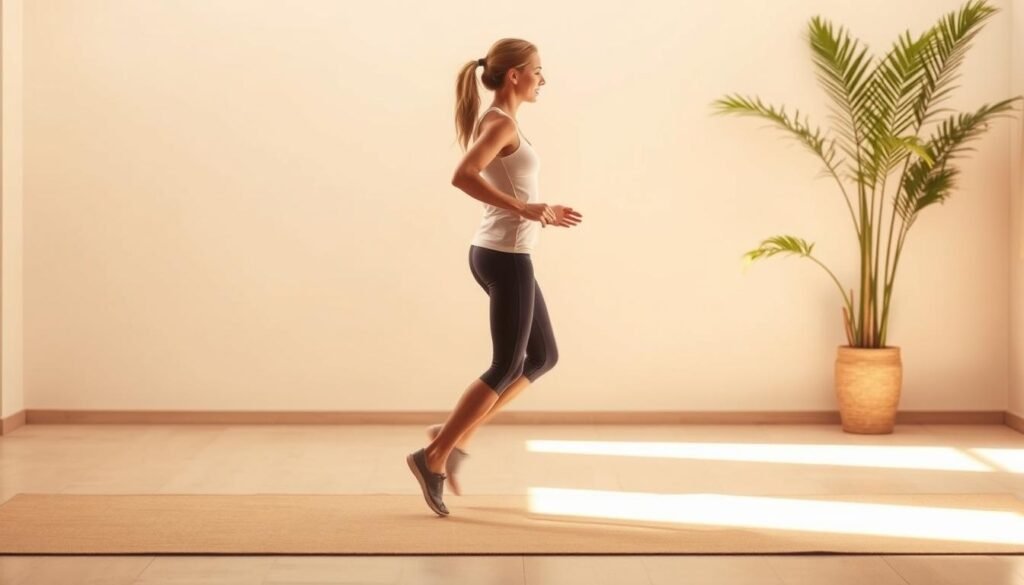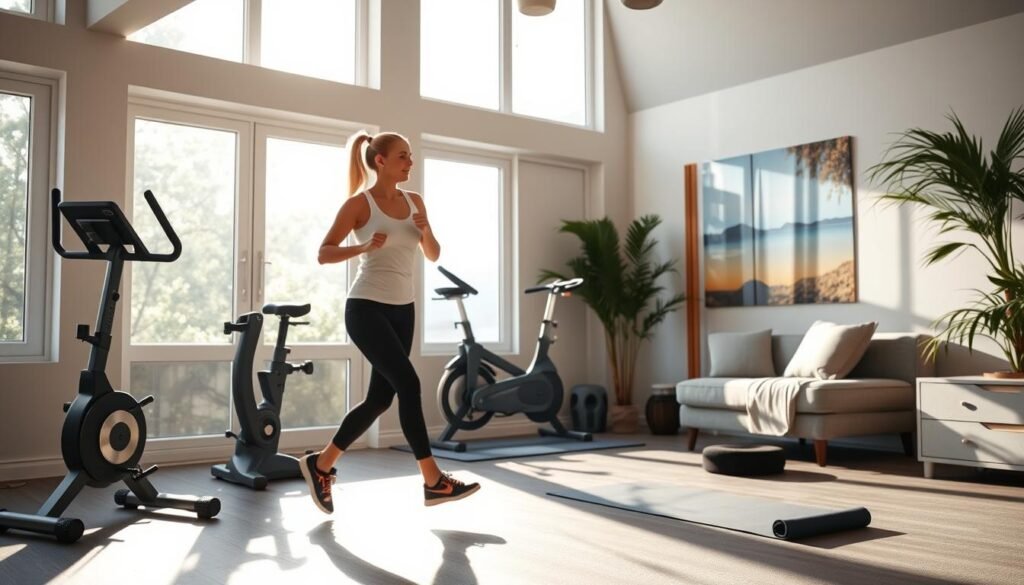
Staying active often feels impossible when every step sends a sharp reminder through your joints. But what if you could strengthen your heart and stamina without sacrificing knee health? We’re breaking down how strategic movement choices can keep you moving forward—pain-free.
Research from Johns Hopkins Medicine confirms that low-intensity workouts reduce strain on sensitive areas while still elevating heart rates. This approach isn’t about avoiding activity—it’s about smartly adapting it. Whether recovering from injury or managing chronic discomfort, the right routine makes all the difference.
In this guide, we highlight methods backed by the American Heart Association and orthopedic experts. You’ll discover how activities like swimming or cycling align with joint preservation goals. Plus, we’ll share insights on balancing intensity with safety—because fitness shouldn’t come at the cost of long-term wellness.
For those seeking structured routines, our partners at SE-Ortho outline science-backed options tailored for mobility challenges. Let’s redefine what “effective training” means when knees need extra care.
Key Takeaways
- Low-impact movements protect joints while improving cardiovascular endurance
- Proper form and gradual progression prevent overexertion
- Water-based activities significantly reduce pressure on sensitive areas
- Consultation with healthcare providers ensures personalized safety
- Consistent moderate effort yields better results than sporadic high intensity
Understanding Knee Pain and the Need for Low-Impact Cardio
Knee discomfort can turn routine movements into daily challenges. From climbing stairs to standing up, even simple actions strain joints already weakened by injury or age. Johns Hopkins Medicine reports that over 25% of adults experience knee pain linked to mechanical stress or inflammation.
What Triggers Joint Discomfort?
Common issues include:
- Sprains: Overstretched ligaments from sudden twists
- Tendonitis: Repetitive motion inflaming connective tissues
- Osteoarthritis: Cartilage breakdown causing bone friction
MyFitnessPal data shows 68% of gym-goers with knee pain unknowingly worsen it through high-impact routines. This highlights why adapting your workout matters.
When to Consult a Specialist
Persistent swelling, instability, or sharp pains during movement signal deeper issues. Physical therapists often recommend pairing low-intensity exercises like cycling with strength training. For example, rowing builds upper-body endurance while sparing joints.
Integrating activities that engage the entire body—without pounding—helps maintain mobility. As one orthopedic nurse practitioner notes: “Prehab beats rehab. Protecting joints today prevents surgeries tomorrow.”
Benefits of Low-Impact Cardio for Knee and Heart Health
Maintaining mobility doesn’t require sacrificing joint comfort. Studies reveal that gentle movements not only preserve knee function but also strengthen cardiovascular systems. The CDC recommends 150 weekly minutes of moderate activity—a target achievable through thoughtful exercise selection.

Protecting Your Joints While Staying Active
Water-based movements like swimming eliminate up to 90% of body weight stress, according to Arthritis Foundation research. This allows full-body engagement without grinding sensations. Regular low-intensity sessions also combat stiffness by promoting synovial fluid circulation in joints.
Enhancing Cardiovascular and Overall Health
Balanced routines deliver dual advantages:
- Heart efficiency: Steady effort improves oxygen uptake without spiking blood pressure
- Muscle synergy: Adding light resistance bands during seated leg lifts builds supportive quad strength
One UCLA study found participants combining aquatic workouts with weekly strength sessions reduced knee discomfort by 34% in eight weeks. As one physical therapist notes: “Movement is medicine when properly dosed.”
Best Cardio Exercise with Bad Knees
Movement becomes medicine when aligned with joint preservation goals. Choosing activities that challenge your heart without pounding your joints requires strategic planning. Let’s explore routines that adapt to your body’s needs while delivering measurable progress.
Walking: Nature’s Adaptive Workout
A brisk 30-minute walk burns calories while keeping ground reaction forces 1.5x lower than running. Opt for soft surfaces like tracks or trails to further cushion steps. Research shows walkers with joint concerns who maintain a 3.5 mph pace improve cardiovascular markers by 18% in six weeks.

Fluid Motion Alternatives
Cycling and elliptical training distribute weight evenly, minimizing pressure points. Water workouts take this further—buoyancy reduces joint load by 50-75%, allowing freer movement. One LA Fitness study found members combining these activities reported 40% less stiffness.
Building Supportive Strength
Pair aerobic sessions with resistance bands or Pilates reformer exercises. These enhance stability in the muscles surrounding vulnerable areas. As trainer Marco Gonzalez notes: “Strong quads and hamstrings act like shock absorbers—they’re your first line of defense.”
| Activity | Impact Level | Primary Muscles Engaged | Ideal For |
|---|---|---|---|
| Swimming | None | Full-body | Severe sensitivity |
| Rowing Machine | Low | Back & legs | Moderate limitations |
| Recumbent Bike | Minimal | Quadriceps | Post-surgery recovery |
Adjust duration and resistance based on your unique condition. Those recovering from ACL injuries might prioritize seated routines, while arthritis patients benefit from water’s warmth and resistance. Always consult your physical therapist when modifying your type of workout.
Cardio Machines Ideal for Knee Pain Relief
Modern fitness equipment offers innovative ways to maintain heart health while respecting joint limitations. Two standout options—elliptical trainers and rowing machines—combine low-impact movement with measurable progress. Let’s explore how these tools help users meet the CDC’s recommended 150 minutes of weekly activity without aggravating sensitive areas.
Why Elliptical Trainers Shine
Ellipticals mimic natural walking patterns while eliminating harsh foot strikes. A Baylor College of Medicine study found they reduce stress knees experience by 35% compared to treadmills. The gliding motion maintains continuous engagement of quads and hamstrings, crucial for stabilizing joints.
Rowing Machine Advantages
This seated powerhouse works 85% of major muscle groups through controlled pulls. Proper form—keeping knees aligned under handles—prevents joint pain while improving range motion. Physical therapists often recommend it for post-surgery recovery due to adjustable resistance levels.
| Feature | Elliptical Trainer | Rowing Machine |
|---|---|---|
| Impact Level | Zero | Low |
| Primary Muscle Groups | Legs & Glutes | Back & Core |
| Ideal For | Arthritis Management | Building Joint Stability |
Start with 10-minute sessions at moderate intensity, gradually increasing duration as tolerance improves. As Dr. Lisa Moreno notes: “Consistency trumps intensity when rebuilding joint confidence.” Pair machine workouts with stretching to maintain flexibility—key for long-term mobility.
Incorporating Strength Training and Flexibility Workouts
Building joint resilience requires more than just movement—it demands strategic reinforcement. Targeted strength routines stabilize vulnerable areas while improving overall mobility. Let’s explore how to blend these elements into your regimen safely.
Low-Impact Strength Routines to Support the Knees
Strengthening surrounding muscle groups reduces strain on joints. Try partial squats (stopping at 45 degrees) or standing hip extensions with resistance bands. These moves build quadriceps and glutes without full knee flexion.
For those experiencing acute knee pain after running, modified lunges prove effective. Step back instead of forward, keeping your weight centered. Physical therapists recommend 2-3 sessions per week for lasting results.
Pilates and Other At-Home Options
Pilates serves as a great option for enhancing balance and alignment. Focus on controlled mat exercises like leg circles or bridging. These improve core stability—critical for proper joint mechanics during cardio exercises.
Pair these with wall sits or seated leg lifts using light ankle weights. A balanced approach combining resistance work and aerobic activity (like a machine-based cardio workout) yields comprehensive benefits.
| Exercise Type | Primary Muscles | Modifications |
|---|---|---|
| Partial Squats | Quads & Glutes | Use chair for support |
| Resistance Band Rows | Upper Back | Adjust band tension |
| Pilates Leg Circles | Hip Flexors | Reduce range of motion |
Start with 10-minute sessions, gradually increasing duration as strength improves. As trainer Alicia Torres advises: “Quality trumps quantity. Proper form protects joints better than any equipment.” Always prioritize controlled movements over speed or weight.
Home Workouts and Accessible Cardio Options
Transforming your living space into a joint-friendly fitness zone requires creativity—not expensive gear. Research shows home-based routines can be equally effective for maintaining heart health when designed thoughtfully. Let’s explore how to build sustainable habits without aggravating sensitive areas.
Creating a Versatile At-Home Routine
Start by breaking activity into 10-minute blocks throughout the day. Morning seated leg lifts, afternoon resistance band rows, and evening stationary cycling sessions cumulatively meet daily movement goals. This approach minimizes prolonged stress while keeping energy levels steady.
Water-filled milk jugs become adjustable weights for arm exercises. Staircases double as step platforms—just face sideways to reduce knee flexion. As physical therapist Dr. Ellen Park notes: “Adaptation beats limitation. Modify movements, but keep progressing.”
Using Minimal Equipment for Maximum Results
A foldable exercise bike offers low-impact pedaling while watching TV. Pair it with wall-assisted squats (stopping at 45 degrees) to build supportive muscle. These strategies lower injury risks better than high-intensity jumps or sprints.
| Activity | Equipment Needed | Duration | Benefits |
|---|---|---|---|
| Stationary Cycling | Exercise bike | 15-20 mins | Improves circulation |
| Seated Leg Lifts | Chair | 3 sets of 12 | Strengthens quads |
| Resistance Band Rows | Theraband | 10 mins | Enhances posture |
Always begin with dynamic stretches—ankle circles or seated marches—to prepare joints. Cool down with gentle hamstring stretches using a towel. Consistency matters more than perfection: three short sessions daily often outperform one exhausting workout.
Conclusion
Joint limitations don’t have to derail your fitness journey. Through smart movement choices, you can maintain heart health while respecting your body’s needs. Prioritizing low-impact options like swimming or cycling preserves joint integrity while delivering cardiovascular benefits—proving activity and protection coexist.
From water-based routines to elliptical sessions, diverse activities cater to varying mobility levels. Pairing these with Pilates enhances stability in muscles surrounding sensitive areas. Consistency matters most: gradual progress builds endurance without overwhelming joints.
Always tailor your approach. What works for post-surgery recovery differs from arthritis management. Consulting healthcare providers ensures routines align with your unique physiology. For detailed guidance, our partners outline science-backed strategies that balance challenge and safety.
Remember—every step counts. Whether it’s a gentle walk or seated resistance work, sustainable habits foster long-term wellness. Your path to a stronger heart and happier joints starts with choosing what fits your life today.
